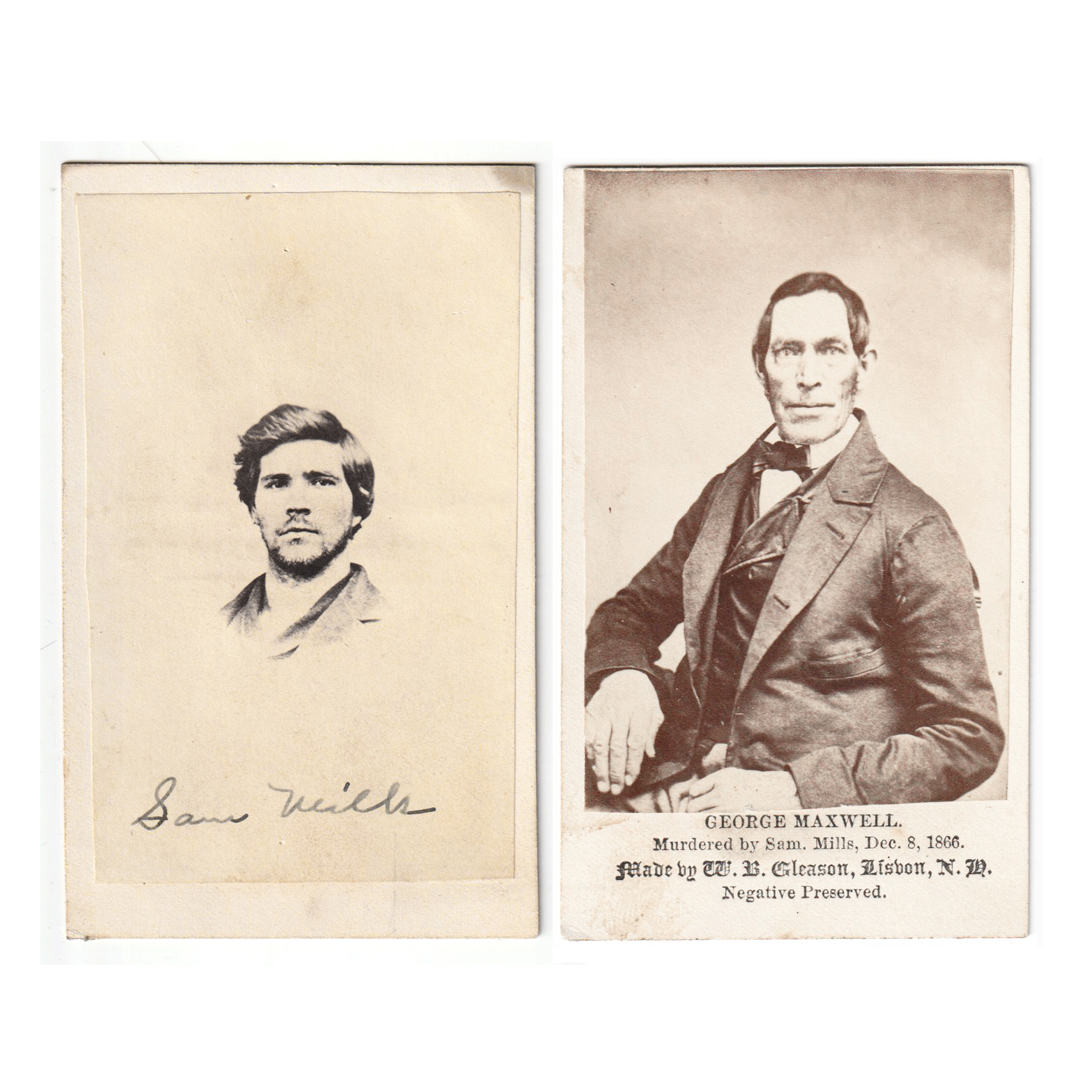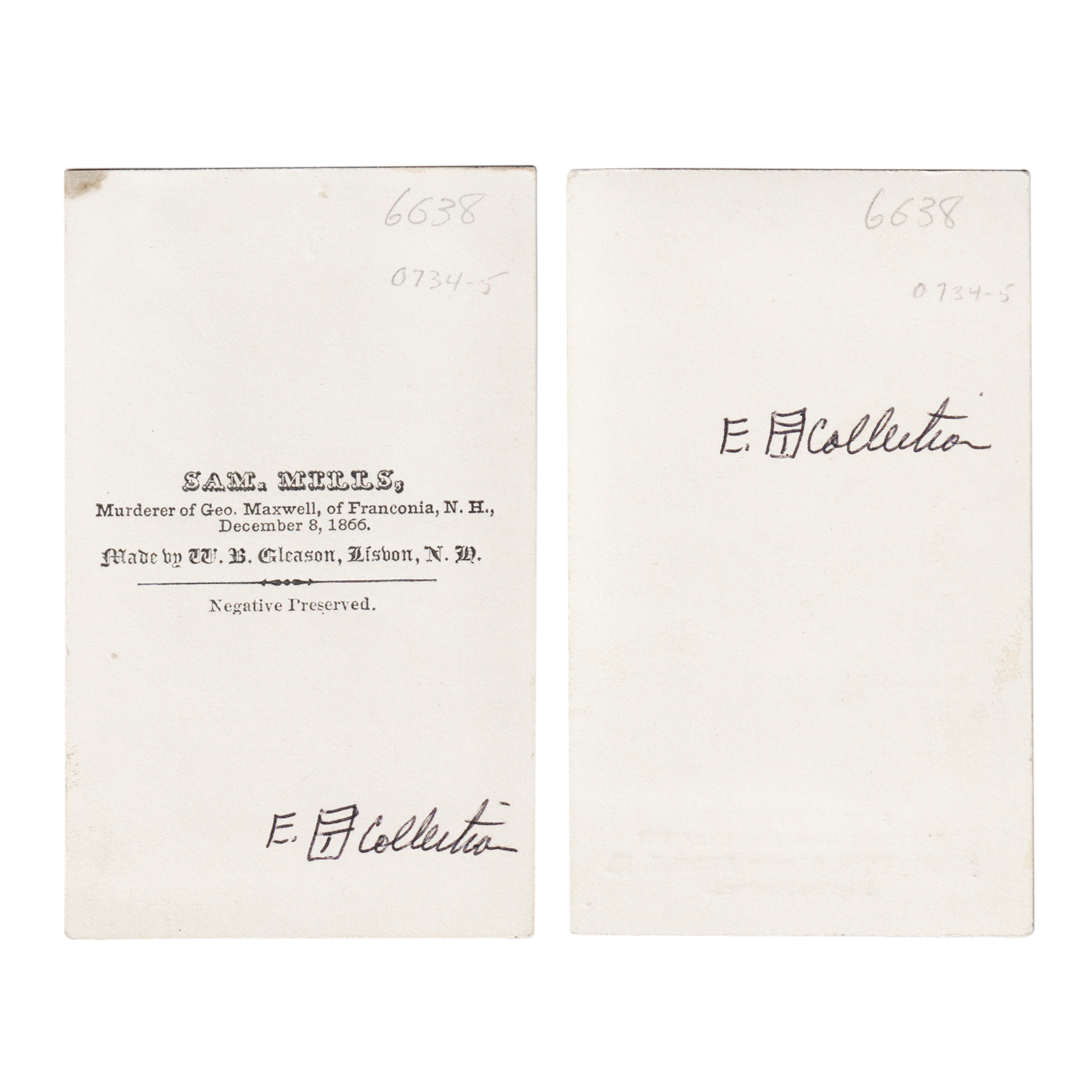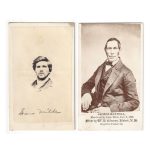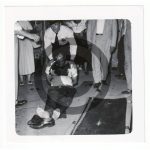Description
Original 1867 CDV Photographs of Murderer Samuel Mills and His Victim George Maxwell
Two original CDV’s, the murderer and the victim. The victim’s photo is captioned in print while the murderers’ photo has an identification in period ink on the face, likely by the photographer’s hand. These were produced as sensational ‘album fillers’ by photographers to capitalize and profit from the tragedies of the day. Often photographers across the country would have access to purchase the rights or simply ‘steal’ the image, in order to reproduce the image, profiteering from the tragedy while satisfying the bloodlust and morbid curiosity of the public.
This was the case of murderer Samuel Mills who’s sensational crime involved the horrific murder of George Maxwell “His face had been pounded to jelly, the head was nearly split in twain and likewise almost severed from the body.’ George Maxwell’s murder, according to the New York Herald, wasn’t a crime —“it was a butchery — a cruel massacre.” The 65-year-old bachelor was found dead in his Franconia, New Hampshire home in December of 1867. The newspaper accounts related that Maxwell’s face “had been pounded to jelly, the head was nearly split in twain and likewise almost severed from the body.” Upon the supper table were two plates indicating “the kind hearted old man was preparing to share his hospitality.” Evidence at the crime scene indicated the murderer calmly sat down with hands “unwashed of the blood…and very coolly and complacently ate a hearty supper leaving pieces of biscuit including the handles of the fork and a teapot all daubed with blood. ”After supper the murderer broke open a trunk stealing several articles and $25 “or there-abouts in money.”
The murderer then stole the old man’s buggy and horse, remembering to take a bag of oats to feed the horse, and then drove off to Gorham, Maine where he boarded a train. At this point New Hampshire police lost his trail. Moses Sargent, a recently retired detective was hired to track down the suspected murderer, 28-year-old Samuel Mills. In short order Mills was apprehended in Illinois and Sargent traveled to Galena to collect Mills for trial. Sargent immediately had Mills pull his pockets inside out and, sure enough, found he had put his bloody hands in his pocket. Sargent cut out the “stained” pocket as evidence of the crime. The duo climbed aboard a train for the 1,600 mile return trip. Stopping in Chicago, Mills, an expert locksmith, was placed in jail in leg irons. During the night, he managed to get a piece of wire from a broom handle, using it to un-locked the manacles. He intended to remove the irons while in the bathroom and jump from the train Sargent however thwarted is plans by refused to allow him to close the bathroom door.
Upon his return, Mills confessed to the crime and was bound over for trial. While in jail he spent his “time…almost wholly occupied in devising means of escape.” On one occasion he skillfully removed the “thirty pound chain around his ankles” and attacked the sheriff. After a “severe struggle” some fellow townsmen joined the sheriff in subduing Mills. A couple of weeks later he sawed the jail bars and “displaced his manacles.” He got as far as Dalton (a town forty miles distant) and was re-captured and returned to his cell. The sheriff had a local blacksmith build a special cell and new manacles to which the smith declared “with an anvil, chisel and hammer they could not be removed.” An hour later, Mills had rid himself of the manacles, opened the cell door and walked out of the jail. Once again he was recaptured and returned to the cell, this time manacled and chained to the floor and a guard was posted outside the cell door. Once again Mills managed to slip out of his manacles and nearly escaped when he was caught removing “some of the stones from the walls.” Finally on May 6, 1868, five months after George Maxwell’s murder, Sam Mills was led to the gallows located 12 feet from his cell. His execution turned “into a general holiday or a sort of a jubilee,” declared the Herald. Mills enjoyed his last meal asserting it “was good.” He had a last smoke and moments before being led to the gallows Mills loosened his clothing to remove a collection of tools which he had ingeniously made from a portion of the wood stove with which he could have affected his escape in an hour if left alone,” wrote the Herald reporter.
Five thousand curious spectators gathered to eagerly watch the execution. They came by carriage and by special trains, “hundreds started at midnight and trudged into town on foot. Mills met with a clergyman and claimed he had made his peace with God. Addressing the crowd, he told them that he was guilty and had “shown himself a man and he will die like a man.” He apologized seconds before the trap was sprung saying, “Good bye, gentlemen, and good luck to all of you.” Someone in the crowd responded “Good bye, Sam — bully for you.” The crowd let out a laugh. Sam’s body dropped eight feet and, according to the Herald “the law was vindicated, justice served, and the multitude departed knowing the world is relieved of at least one of the most heartless wretches that ever disgraced it.”








